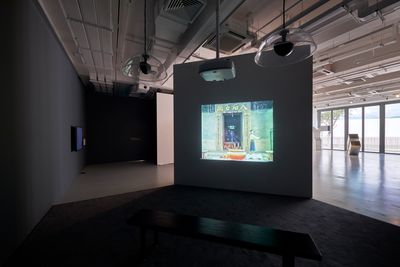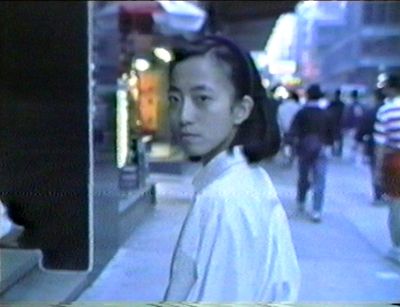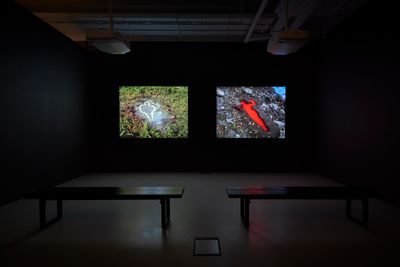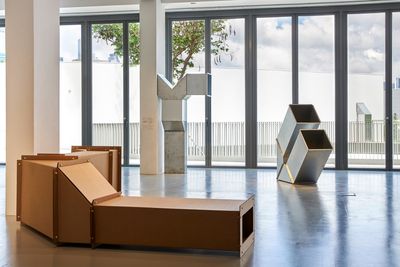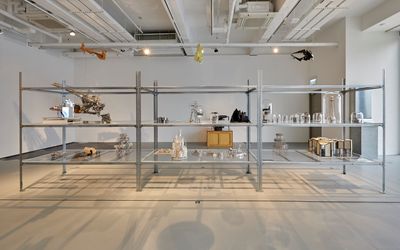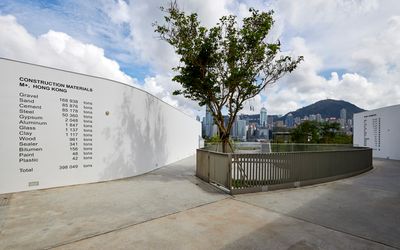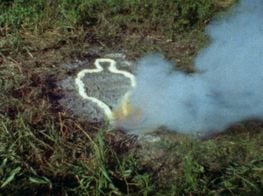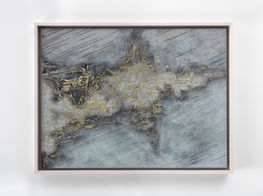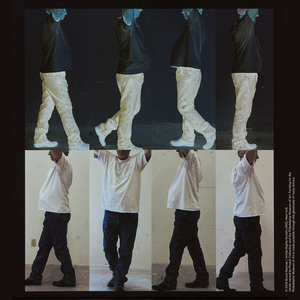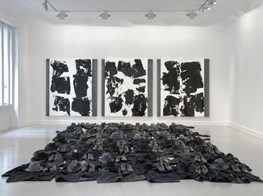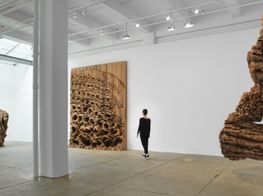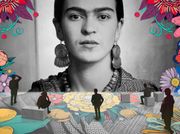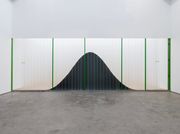'Sites Encountered': A Chorus of Five Artists at M+ Pavilion
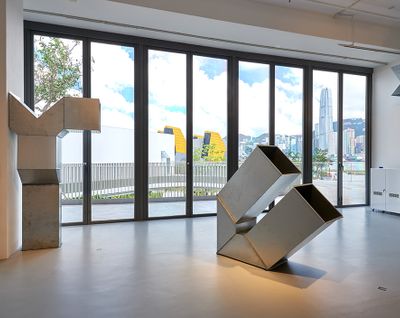
Charlotte Posenenske, Series D Vierkantrohre (1967/2014). Exhibition view: Five Artists: Sites Encountered, M+ Pavilion, Hong Kong (7 June–20 October 2019). Courtesy M+, Hong Kong.
Without punctuation, She Said Why Me, the title of May Fung's 1989 video presents itself as a statement, rather than a question. It suggests a subject who expects no response, a person prepared to make what she can from being chosen though perplexed by the attention. The video follows a blindfolded woman, then unmasked, through late colonial-era Hong Kong. In the context of Five Artists: Sites Encountered (7 June–20 October 2019), the most recent exhibition at the West Kowloon Cultural District's M+ Pavilion, the title of this important work of Hong Kong new media art also feels like a mantra.
Featuring five women artists from Hong Kong, Cuba, Germany, Spain, and South Korea, Five Artists is an international, cross-generational reflection on the idea of site—'from intangible to tangible and imagined to real.' But the show has also been described by M+ as a 'prelude' and a 'gateway' of sorts, carrying 'special resonance' with the site where the M+ Pavilion is located, just a short walk away from the much-anticipated, soon-to-be-completed M+ building. As a 'prelude', Five Artists is posed to reflect on what is to come as the Herzog & de Meuron designed M+ building opens. As a 'gateway', it seeks to open considerations about the reclaimed land of the cultural district as the museum's 'locale'.
Between the past of M+ as Hong Kong's iconic museum-in-becoming and its future as an iconic museum-to-be, this exhibition states: 'why me'. Fung's video is owned by M+, Lara Almarcegui's project was commissioned for the show, Charlotte Posenenske's and Ana Mendieta's works are in the process of acquisition, and a Lee Bul sculpture was lent by a prestigious private collection.
Yet, beyond demonstrations of institutional networking and aims to legitimate purchases with the public, the biographies of the five artists on show suggest that curator Pauline Yao also brought them together for the way they enact withdrawal and refusal. Fung has asserted her fondness for being 'on the fringe'. Posenenske stopped making art in the late 1960s to work as a sociologist specialised in labour relations. Almarcegui's assemblages of rubble and waste deposits are the Anthropocene's landscapes of refuse. Lee's queering of monumental modernism with craftwork revisits the past to challenge the persistent top-down tendencies of visionary urbanism. The distressing conditions of Mendieta's premature death often determine the thinking around her practice, in which she exposes herself and removes herself from view, manipulating the viewer's voyeurism with tactical intent.
How this exhibition exceeds itself is by operating less as a show than a gathering—less about 'site' than about the affect of experimental 'encountering' between five well-chosen artists. Fung's She Said Why Me opens with still shots of two old photographs depicting a child and an older woman; then transitions to the video's first colour sequence, which captures a slight figure at an age in between. At a temple to the sea goddess, Tin Hau, performer Pik-Yu Chan of Zuni Icosahedron traverses the frame from left to right. Eight minutes of edits combining original and archival footage follow, at the beginning of which Chan's blindfold falls to the ground while she moves through British colonial Hong Kong eight years before the transfer of sovereignty to China. At the end, Chan returns to the temple, crossing right to left behind the same incense, as if the video itself is an offering.
Feeling her way over stone and brick, Chan's body is caught in the sliver of space between the frame we watch her in and the walls she moves along. From the Cenotaph memorialising war dead at Statue Square to a busy commercial strip that evokes the feeling of Queen's Road, Fung's editing choreographs Chan's movements in a 'dance' with historical clips. Incense smoke cuts to smoke from a ferry in an old harbour scene; images of Chan running frantically amidst collapsed scaffolds are replaced by an agitated camera following a woman picketing in the 1967 uprisings against colonial rule. The next scene closes in on the back of Chan's head as men and women in business attire pass by on a busy thoroughfare. She whips her head around to stare back at her pursuer. The closing titles tell us the video was shot in December 1989, six months after student protests ended in violence in Beijing's Tiananmen Square.
Artist and theorist Hector Rodriguez cites Fung's 'collage' as an example of Hong Kong's 'culture of the fragmented commonplace'. The soundtrack of piano music, which sutures the seams of Fung's edits, is also used as 'thread' in Yao's exhibition, itself in empathy with the 'culture' Rodriguez theorises. The piano accompanies visitor encounters with all the works installed both in the pavilion's interior space and on the outdoor platform beyond glazed doors. In a show so focused on materiality and context, however, it is unfortunate that Fung's VHS is presented in digitised projection; but this choice does help compress time so the video can act as connecting tissue. Fung always works for others. She is co-founder of Hong Kong's new media art collective Videotage, and initiator of Art & Culture Outreach, a project to create more physical space for the arts amidst raging speculative urbanism. When consulted in the selection of books for the M+ bookshop, she chose the works of artists she supports. At her museum talk on 25 July, she will discuss the work of Cuban-born, Iowa-trained Ana Mendieta.
Fung's piano follows the spectral cycling between appearance and disappearance in Mendieta's 'Silueta' series (1974–1981), including Silueta Sangrienta (Bloody Silhouette, 1975), which sees Mendieta's nude body disappear then reappear by editing tricks. First seen face up in an earthen silhouette filled liquid-red, Mendieta's body vanishes then returns in a final disquieting apparition in which she is face down in the same carmine-pigmented body-shaped pool. With its Super 8 grain digitised to pixel noise, the presentation is another lost opportunity to give value to analogue acetate, but Mendieta's powerful contours always belie their flattening.
Dispersed throughout the space—including before a doorway that leads to two projections of Mendieta's performance-films—German artist Charlotte Posenenske's modular sculptures in steel and cardboard appear like slender throats and open mouths, slinking and standing to the trills and chords of the piano carrying through the space from Fung's video. Placed near Mendieta's works at the Pavilion, Posenenske's objects, typically described as resembling ventilation shafts, are instead writhing organs of infrastructure channeling the actual and the unknown. Series D Vierkantrohre (Series D Square Tubes) (1967/2014) and Series DW Vierkantrohre (Series DW Square Tubes) (1967/2007, 1967/2013) are units that will be placed and arranged in configurations by a 'user' throughout the course of the show, not just by the curator but by three invited guests, including Hong Kong artist Sara Wong.
South Korean sculptor Lee Bul's 39 maquettes in mostly foamex and steel still evoke the German expressionist and Russian avantgarde experiments that inspired them. But encrusted with the crystals of Bruno Taut, buttressed by the sweeping beams of Vladimir Tatlin, and nested under synthetic hair that recalls the heresies of Friedrich Kiesler, these models—presented on pedestals, ordered on shelves, and suspended from the ceiling—also appear feasible propositions for Hong Kong. The government is planning underground cavern districts and artificial islands, while the island's beaches remain covered with Styrofoam beads from Typhoon Mangkhut.
From inside the Pavilion, the piano from Fung's video gives sentiment to the sans-serif coolness of Rotterdam-based Spanish artist Lara Almarcegui's lists, titled Construction Materials (2006–2019), outside. Almarcegui's accounting, painted on walls around the Pavilion's outer platform, reports quantities of 13 substances from gravel to plastic. The list in English faces the Pavilion's glazed doors while the same list in Traditional Chinese faces the harbour. Beginning and ending a trajectory around the Pavilion's green burial-mound-like berm, the two lists inspire association with the charts of workers' hours posted around the cultural district. The body is the material not present in Almarcegui's list.
Just as the piano from Fung's video ranges from sombre to melancholic, Five Artists: Sites Encountered shifts from mundane to fantastic, from ludic to mournful. Driven less by a theme than the incantation that titles Yao's curatorial statement, 'On site, in context, with place', the show transports viewers from their respective 'elsewheres' back to Hong Kong's here-and-now. This grounded approach proved prescient, given recent events in the city. On my visit, I left the exhibition connecting Posenenske's square tubes and Lee Bul's maquettes with the crowd-control barricades that anti-extradition protesters used as ladders to climb over concrete barriers. Returning to Kowloon station past billboards for developments on reclaimed land, an imagined line for Almarcegui's lists came to mind: 150 tear gas canisters fired.—[O]
—
The writer thanks the guards and museum attendants who assisted in identifying locations in May Fung's video for this text.

